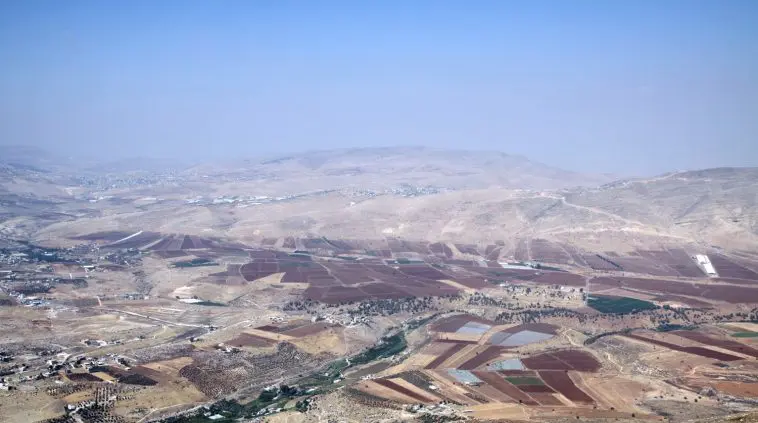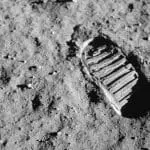Then Joshua built an altar unto the Lord God of Israel in mount Ebal, as Moses the servant of the Lord commanded the children of Israel, as it is written in the book of the law of Moses, an altar of whole stones, over which no man hath lift up any iron: and they offered thereon burnt offerings unto the Lord, and sacrificed peace offerings. And he wrote there upon the stones a copy of the law of Moses, which he wrote in the presence of the children of Israel. And all Israel, and their elders, and officers, and their judges, stood on this side the ark and on that side before the priests the Levites, which bare the ark of the covenant of the Lord, as well the stranger, as he that was born among them; half of them over against mount Gerizim, and half of them over against mount Ebal; as Moses the servant of the Lord had commanded before, that they should bless the people of Israel. And afterward he read all the words of the law, the blessings and cursings, according to all that is written in the book of the law. There was not a word of all that Moses commanded, which Joshua read not before all the congregation of Israel, with the women, and the little ones, and the strangers that were conversant among them. (Joshua 8:30–35)
In Part 6A, we examined the discovery of Joshua’s altar on Mount Ebal in the central highlands of Israel by archaeologist Adam Zertal. Joshua’s altar, the biblical altar, was found underneath a later and larger altar reverentially built directly over top of Joshua’s altar, preserving Joshua’s altar intact. The construction of this very altar is recorded in Scripture in Joshua 8. This altar is not just some insignificant artifact but relates to one of the most important aspects of biblical Israel’s history, the ceremony which inaugurated Israel as a nation and covenanted to the LORD. This is a truly momentous discovery, rich in its implications.
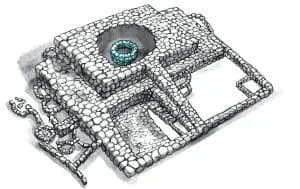
In Part 6B, we considered the chronology of Joshua’s altar which, as we saw, dates to 1406 BC, after Israel’s entrance into the promised land, and immediately after the destruction of Jericho and Ai.
Both the what and the when of Joshua’s altar are of great significance at multiple levels. For example, we noted in Part 6A that the academic establishment in the West and the academic establishment of the Islamic countries are united, hand in hand, denying the historicity of the Pentateuch and the book of Joshua: as the old proverb says, “the enemy of my enemy is my friend.” Both have their thinly veiled motivations.
In Western academia, philosophical naturalism (which is a religious faith) sits enthroned as the reigning imperative. The naturalists are adamantly (I don’t think it is unfair to say fanatically) committed to the proposition, as enunciated by Richard Lewontin, “We cannot allow a Divine foot in the door.” (See Part 1 of this series.)
This devotion to the religion of naturalism has a very great effect on the interpretation and assessment of raw data. The same is true among Islamic scholars. They are committed to the supremacy of Islam which involves the denial of anything even remotely suggesting an Israelite claim to the land of Canaan, in the present or the past. Both are committed to denying the reality of Joshua’s altar, or at least ignoring or marginalizing its reality to the point of irrelevance.
However, as US President John Adams once said, “Facts are stubborn things.”
Among the implications of the discovery of Joshua’s altar is that it is a definitive death blow to the documentary hypothesis, which is an entirely subjective hypothesis. Given the reality of Joshua’s altar and its unquestionable antiquity, it is simply not possible that the speculations of the advocates of the Documentary Hypothesis are anything beyond mere subjective fantasies.
The proponents of the documentary hypothesis speculate, among other things, that the Israelites arose several hundreds of years later than proclaimed by Scripture. This chronology is absolutely essential to their speculations. Without it, the entire hypothesis crumbles to dust. They also imagine that the earliest Israelites were illiterate and that the written Hebrew language also came along hundreds of years later than proclaimed by Scripture.
According to them, the biblical accounts of the patriarchs, and even the early kings such as Saul, David, and Solomon, are all national myths falsely concocted to inspire national patriotism among a fledgling Israelite nation. The Israelites, they say, were an indigenous Canaanite clan, or perhaps from Edom or Moab, who were never in Egypt and never had an Exodus.
The documentary hypothesis is utterly discredited even if we accept archaeologist Adam Zertal’s late-dating of Joshua’s altar as being in the middle of the 13th Century BC (roughly 1250 BC rather than the Scriptural 1406 BC). Honest academicians will abandon the documentary hypothesis as a baseless fantasy. Joshua’s altar, like Elijah taunting the priests of Baal, sits there as a tangible, empirical fact of reality mocking the secularists and their delusions.
Facts are stubborn things, indeed!
Will the Real Mount Gerizim Please Stand Up?
Zertal’s discovery of Joshua’s altar was not without an apparent discrepancy. An undoubted Israeli altar on Mount Ebal exhibiting all the features one would expect of the biblical site in Joshua 8, including ancient chronology, was a powerful confirmation of the historicity of the biblical record…but then there was Mount Gerizim.
The Scripture in Joshua 8 states that when the blessings and curses were pronounced, half of the tribes stood facing Mount Ebal and the other half of the tribes facing Mount Gerizim with the Levitical priests and the Ark of the Covenant between the two camps. In Joshua 8, we are told: “half of them over against mount Gerizim, and half of them over against mount Ebal; as Moses the servant of the LORD had commanded.” This is obviously in obedience to the command given in Deuteronomy 27:
These shall stand upon mount Gerizim to bless the people…
And these shall stand upon mount Ebal to curse…
The phrases “stand upon” in Deuteronomy 27 and “over against” (el mul in Hebrew) in Joshua 8 are understood as synonymous expressions since Joshua 8 is explicitly said to be in obedience to Moses’ command, and the phrases have the signification of “facing toward” as we would express it in English. (See Zertal, pg 148 of A Nation Born.)
The tribes were divided as follows:
- facing Gerizim – Simeon, Levi, Judah, Issachar, Joseph, and Benjamin;
- facing Ebal – Reuben, Gad, Asher, Zebulun, Dan, and Naphtali.
The problem for identifying the altars on Mount Ebal as Joshua’s altar, as was pointed out by Zertal’s critics, is that the altars on Mount Ebal are not visible from Mount Gerizim and are situated on the opposite side of Mount Ebal from Gerizim on the northeastern slope! The altars face a different mountain, Mount Kabir to the east, not Mount Gerizim to the south. How could such a ceremony possibly be conducted facing Mount Gerizim considering this geography and the location of the altars? This objection has some force to it. This seems to be a glaring contradiction.
Additionally, to make matters even more complicated, there is also no mention of the city of Shechem in Joshua 8, a detail which seems wholly inexplicable considering that Shechem is located in the valley between Mount Gerizim and Mount Ebal. The city of Shechem, like Mount Gerizim, is not visible from the site of the altar which is situated on the Northeastern slope of Ebal.
Now, this detail regarding Shechem is not decisive as an argument against identifying Zertal’s altar as Joshua’s altar, as it constitutes an argument from silence; nevertheless, this is a very curious omission, indeed, if the ceremony was conducted as per Scripture. Of these two details, the lack of visibility of Mount Gerizim from the site of the Mount Ebal altars is the most problematic and seems to directly contradict the biblical text.
Curiously, there doesn’t appear to be any discussion whatsoever on the part of Bible scholars, liberal or conservative, at least none that I have been able to find, discussing the problem of Mount Gerizim in relation to Zertal’s discovery of the altars. This is, however, a prominent part of Zertal’s book, A Nation Born, and I don’t understand the reticence of conservative scholars to address it.
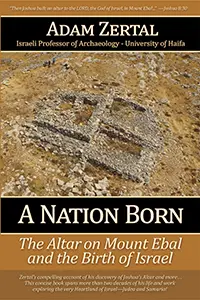
The archaeological searches that had been conducted for Joshua’s altar before Adam Zertal, following the biblical texts, concentrated on the southern slope of Mount Ebal facing Mount Gerizim but absolutely no hint or trace of anything significant was ever found on the southern slope of Ebal. This seems inexplicable.
How can this apparent discrepancy be explained? Has the long erosion of the relentless centuries erased all the physical evidence of the altar on the southern slope? Or are the altars Zertal found on the northeastern slope of Ebal simply not Joshua’s altar(s)? Is it all a myth? Needless to say, this is the preferred explanation of the Bible deniers.
A little focus on a map of the geography will help us grasp the problem here. The biblical city of Shechem sits in the valley between Mount Ebal and Mount Gerizim, with Gerizim to the south, Ebal to the north and slightly east. The altars were discovered on the northeastern slope of Ebal far below the summit. Mount Gerizim is not visible from the location of the altars on the northeastern slope and neither is the city of Shechem.
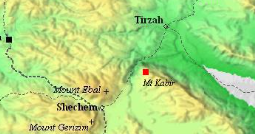
The passage in Joshua 8 requires that the two divisions of the Israelite tribes face their respective mountains with the Levitical priests and the Ark of the Covenant in between them. If we accept that the altars on Mount Ebal are, indeed, the site of Joshua’s altar and that the ceremony happened as described in Joshua, then modern Mount Gerizim cannot possibly be the Gerizim of the Bible. The real Mount Gerizim would have to be the Mount that does face the altar. This would make Mount Kabir to the east of Ebal the true biblical Gerizim!
Zertal says that this is precisely the answer to the dilemma here. He writes about the moment when this possibility was first suggested to him by an American volunteer at the excavation site:
Among the volunteers who participated in the 1987 season at Mount Ebal, there was an American priest…If I remember his name correctly, it was John Wilkinson…
Wilkinson pulled at my sleeve…Standing beside the spring he said: ‘Adam, I have an idea.’ There was no shortage of ideas among the Americans, but I listened. ‘If,’ began Wilkinson in his thick accent, ‘we assume that Mount Gerizim is here, opposite us, at Mount Kabir.’ ‘But on the other Mount Gerizim stands the Samaritan sanctuary,’ I said. ‘And the tradition there goes back to ancient times.’ ‘Quite so,’ said Wilkinson,’ I am thinking about the Bible. The Bible is always right…’ he trailed off.
We dropped the matter and the naïve gentleman went away with his American friends…The idea, though, had been permanently implanted in my mind. I suddenly allowed myself to make a simple assumption. The descriptions in both Deuteronomy and Joshua had been accurate so far, so why shouldn’t they be right about this, too? In that case, the location of the ancient, original Mount Gerizim must be on Mount Kabir.” – pg 149, A Nation Born
Those of us who know the Lord will recognize the hand of divine providence in this exchange between Wilkinson and Zertal.
If Mount Kabir is the true biblical Mount Gerizim, how and when did modern (i.e., Samaritan) Mount Gerizim become designated as the Gerizim of the Bible? And if the southern mountain is not the Gerizim of the Bible, then does the Bible give us a name for this mountain? Is such a longstanding misidentification of Mount Gerizim plausible? According to Adam Zertal, yes! And how long exactly has this misidentification of Gerizim gone back in history? How, and when, did we come to identify the mountain on the south side of Ebal as Mount Gerizim?
Credit needs to be given to Adam Zertal for expertly and convincingly unraveling this mystery. This is superb investigatory and analytical work. His book, A Nation Born, reminds me of Joseph Weiner’s book, The Piltdown Forgery. Like Weiner’s systematic deconstruction of the Piltdown Man fraud committed by Charles Dawson, Zertal methodically unravels the ancient fraud of the Samaritan sect regarding Mount Gerizim, as well as their strategic alterations of the Samaritan Pentateuch. The big difference is that the fraud of the Samaritans lasted much, much longer.
Mount Gerizim in History
There were roughly 1,000 years between the abandonment of Mount Ebal ca. 1150 BC and the Samaritan claim to Mount Gerizim, full of a tumultuous history, including the Assyrian and Babylonian deportations of the native populations of Israel and Judah. The altars on Mount Ebal were abandoned and deliberately concealed ca. 1150 BC and there is not a single word in Scripture about Mount Ebal after Joshua 8.
The Samaritans built their sanctuary ca. 200 BC, claiming their site to be the Mount Gerizim of Scripture. They also claimed Mount Gerizim, not Mount Ebal, was where the location of the ceremony of the blessings and curses was conducted in their version of the Pentateuch, the Samaritan Pentateuch. These claims deviate from the Masoretic text of the Pentateuch and are obvious, suspicious red flags. (Zertal discusses all of this at length in Chapter 12, titled “Distant Brothers,” of his book, A Nation Born, pgs 138–155.)
The deviations in the Samaritan Pentateuch on these strategic details suggest that the alterations were deliberate corruptions of the biblical text to legitimize their sect. Outcasts from Jerusalem, the Samaritans appropriated the biblical history of Ebal and Gerizim as their own and built their own sanctuary separate from the Temple in Jerusalem.
Mount Zalmon
If modern (Samaritan) Mount Gerizim is not the Mount Gerizim of the Bible, then is this Southern Mount identified in the Bible? According to Zertal, the Southern Mount is Mount Zalmon of the Bible. Judges 9 tells us of the incident when Jotham ascended Mount Gerizim and proclaimed a parable to the people in the city of Shechem below, and then later in the chapter Abimelech, his nemesis, ascends Mount Zalmon to cut down trees to use to burn his enemies who had escaped for refuge in the tower of Shechem. So clearly, the three mounts that surround Shechem are Ebal, Gerizim, and Zalmon.
There is no dispute about the identity of Ebal, especially now that the altars have been found there. Zertal contends that Samaritan Mount Gerizim is Mount Zalmon of Scripture, and I believe the facts agree with this conclusion.
The biblical maps in our Bibles need to be revised with Ebal to the north of Shechem, Gerizim to the east of Shechem, and Zalmon to the south of Shechem.
In conclusion, the city of Shechem is not mentioned in Joshua 8 precisely because it was neither involved nor in view from the location of the ceremony on Mount Ebal; and the reason modern (Samaritan) Mount Gerizim cannot be seen from the location of Joshua’s altar on Mount Ebal is because it is not the Mount Gerizim of the Bible. Mount Kabir (to the east of Ebal) is the biblical Mount Gerizim.
Modern Mount Gerizim is called Mount Zalmon in Scripture. We can confidently conclude that these troublesome details regarding Mount Ebal and Mount Gerizim and their history and identities have been resolved. There remains no detail or obstacle contradicting the identification of the (older) altar discovered on Mount Ebal as Joshua’s altar.
We will continue our examination of the discovery of Joshua’s altar and its antiquity in Part 6D.

